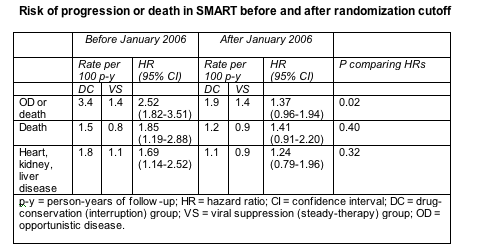 |
 |
 |
| |
Resuming Therapy Can't Reverse Progression Risk With Off-and-On Therapy
|
| |
| |
15th Conference on Retroviruses and Opportunistic Infections
February 3-6, 2008
Boston
Mark Mascolini
Resuming antiretroviral therapy for over 2 years in the SMART trial did not erase the higher risk of progression to AIDS, non-AIDS diseases, or death in the interruption group [1]. Sluggish CD4 gains in interrupters restarting therapy and inconsistent restarting trends appeared to explain the sustained progression risk. Wafaa El-Sadr (Harlem Hospital Center, New York) told journalists the new results reinforce SMART's conclusion not to suspend antiretroviral therapy (ART) with a high CD4 count.
SMART results headlined the 2006 Conference on Retroviruses, when El-Sadr and colleagues reported that CD4-guided drug holidays (stop above 350 cells, restart below 250) boosted the risk of opportunistic disease or death from any cause 2.6 times [2]. People who interrupted ART ran a 1.8 times higher risk of death from any cause, and a 1.7 times higher risk of major cardiovascular, renal, or hepatic disease.
The researchers stopped the randomized phase of the trial on January 11, 2006 and encouraged everyone in the interruption arm to resume steady therapy. At the 2008 Conference El-Sadr explained what happened to SMART participants advised to restart treatment and tracked through July 11, 2007, comparing them with people originally assigned to the steady-therapy group.
Before January 2006 people in the off-and-on group spent 34% of the time taking ART, compared with 94% in the steady-therapy group. After the January cutoff, time on ART doubled in the interruption group but did not catch up with time on treatment in the steady-therapy group (71% versus 91%). Whereas the drug-holiday group spent 31% of the time with a CD4 count under 350 before January 2006, they spent 23% of the time under 350 after that date. But the control group spent only 8% of the time before January 2006 and 7% of the time after that with a sub-350 CD4 tally. From January 2006 through July 2007, CD4 counts in interrupters resuming ART did not return to where they were when SMART began.
In January 2006, when the randomized part of SMART stopped, rates of opportunistic disease or death were more than twice as high in the stop-and-go group than in the control group, death rates were almost twice as high, and rates of cardiovascular, renal, and hepatic complications were 69% higher (table). Rates of these three endpoints improved in holiday takers when they resumed therapy in January 2006 but still lagged rates in the steady-therapy group: After January 2006 people originally assigned to the interruption group had a 37% higher risk of opportunistic disease or death, a 41% higher risk of death, and a 24% higher risk of heart, kidney, or liver disease (table).

The 113 interrupters and 50 noninterrupters who suffered a nonfatal opportunistic, cardiovascular, renal, or hepatic complication before January 2006 had nearly a 6 times higher risk of death after that date, a highly mortality risk (hazard ratio 5.8, 95% confidence interval 3.2 to 10.8, P < 0.00001).
Why did the interruption group fail to catch up to the control group in progression risk after resuming steady therapy? One reason appears to be that holiday takers did not spend as much time taking ART after January 2006, when investigators counseled them to resume treatment. As noted, after that date the off-and-on group spent 71% of the time on therapy, compared with 91% in the control group. When D:A:D investigators looked at people in both study arms who spent more than 85% of their time on ART after January 2006, risk of opportunistic disease or death proved equivalent in the two groups. A similar statistical adjustment for CD4 count after January 2006 suggested that persistently lower CD4s in interrupters contributed to their sustained progression risk.
Reviewing all these results, SMART investigators suggested three possibilities for higher risk of progression among interrupters after the January 2006 cutoff:
1. Some interrupters did not resume therapy.
2. CD4 counts stayed lower in interrupters than in noninterrupters even if they restarted therapy.
3. HIV-related and other diseases diagnosed before January 2006 had long-term consequences.
The SMART team suggested that implications of these findings may extend beyond CD4-guided drug breaks to any drug-holiday strategy. But the investigators also cautioned that longer follow-up may have showed a further slowing of progression in the treatment interruption arm.
References
1. El-Sadr W and SMART Study Group. Re-initiation of ART in the CD4-guided ART interruption group in the SMART study lowers risk of opportunistic disease or death. 15th Conference on Retroviruses and Opportunistic Infections. February 3-6, 2008. Boston. Abstract 36.
2. Strategies for Management of Antiretroviral Therapy (SMART) Study Group, El-Sadr WM, Lundgren JD, Neaton JD, et al. CD4+ count-guided interruption of antiretroviral treatment. N Engl J Med. 2006;355:2283-2296.
|
| |
|
 |
 |
|
|